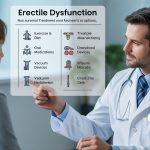Key Takeaways
- There are several effective non-surgical treatments for erectile dysfunction (ED), offering hope for men looking to avoid surgery or oral medications.
- Options such as shockwave therapy, platelet-rich plasma (PRP) therapy, acoustic wave therapy, and vacuum erection devices are supported by growing clinical evidence.
- Consultation with a healthcare provider is crucial in selecting the right approach tailored to individual health needs and lifestyle preferences.
Understanding Erectile Dysfunction
Erectile dysfunction (ED) is a condition that affects millions of men around the globe, disrupting intimacy, confidence, and overall quality of life. It is estimated that nearly half of men over the age of 40 experience ED to some degree, making it one of the most common sexual health challenges faced today. ED can result from a combination of physical and emotional factors such as vascular disease, neurological disorders, hormonal imbalances, anxiety, depression, or chronic stress. Lifestyle habits like smoking, excessive alcohol use, poor diet, and lack of exercise can further contribute to decreased erectile function.
As traditional medications like sildenafil (Viagra) and tadalafil (Cialis) are not always suitable for everyone—due to side effects, interactions with other medications, or underlying health issues—many individuals are turning to non-surgical approaches for relief.
Seeking alternatives doesn’t mean sacrificing efficacy. Across the country, advancements in medical science have unlocked a variety of non-invasive therapies for men with ED. In fact, several leading institutions and clinics now offer specialized care for erectile dysfunction, utilizing technology and biologic treatments to provide long-lasting improvement. If you want to explore innovative care options, the region offers resources like men’s ED treatment in Sacramento, CA that blend modern intervention with personalized care and support.
The journey to overcoming ED starts with a comprehensive understanding of the underlying cause. Whether the challenge is physiological, such as diabetes or vascular disease, or psychological, like performance anxiety or relationship concerns, today’s treatment spectrum can cater to patient preferences while minimizing risk factors associated with surgery. A thorough assessment by a qualified specialist is the first step in developing a personalized, effective treatment plan.
Shockwave Therapy
One of the most promising innovations in ED treatment is Low-Intensity Extracorporeal Shockwave Therapy (LI-ESWT), which uses targeted acoustic waves to rejuvenate penile tissue. This therapy promotes the formation of new blood vessels and enhances circulation—effectively addressing one of the most common causes of ED: restricted blood flow. During a session, a physician uses a specialized device to deliver gentle pulses along the penis, stimulating natural regeneration and improved vascularization.
Early clinical trials indicate notable improvements in erectile strength and quality, particularly in cases of vasculogenic ED, which results from poor circulation. Unlike medications that provide only temporary benefit, shockwave therapy may lead to sustained improvement, potentially reducing dependence on drugs over time. This non-invasive technique requires no anesthesia, making it accessible for most patients. Sessions last about 15 to 20 minutes, with little discomfort reported during or after the procedure.
Side effects from shockwave therapy are rare and typically mild, limited mostly to transient redness or tingling. It is important, however, to seek treatment from a qualified provider, as proper technique and equipment are essential for safety and effectiveness.
Platelet-Rich Plasma (PRP) Therapy

PRP therapy is a regenerative treatment that harnesses the patient’s blood platelets, injecting them into penile tissues to accelerate repair and improve vascular health. After drawing a small amount of blood, specialists use a centrifuge to concentrate growth factors found in platelets. These concentrated platelets are then reintroduced via injection, stimulating natural healing and potentially increasing blood flow and sensitivity.
The appeal of PRP lies in its minimal invasiveness and utilization of natural healing mechanisms, limiting the risk of allergic reactions or side effects. Peer-reviewed studies reveal that PRP can increase erectile function and sensitivity without significant risk of adverse effects, making it a compelling option for those seeking an alternative to pharmaceutical approaches. Many patients undergo treatments spaced several weeks apart, with improvements sometimes noticed after the first or second session.
While more research is necessary to define the long-term benefits of PRP for ED, early results are encouraging, especially for men with mild to moderate dysfunction or for those seeking to enhance outcomes from other therapies. As with other interventions, a consultation with a knowledgeable clinician is key to determining if PRP is appropriate.
Acoustic Wave Therapy
Closely related to shockwave therapy, acoustic wave therapy also employs sound waves to break up microplaque in blood vessels and stimulate new tissue growth. Over time, microplaque buildup can compromise blood flow and contribute to ED. By dispersing the plaque and invigorating the generation of new, healthier blood vessels, acoustic wave therapy can restore youthful erectile function.
Patients report enhanced blood flow and improved erections within weeks, with virtually no downtime or side effects. Appointments take about 20 minutes, and most patients can return to their daily activities immediately after treatment. While the mechanisms are still being studied, acoustic wave therapy has gained popularity among men who prefer entirely non-invasive treatment modalities.
This option may be especially appealing to men whose ED is primarily caused by circulatory problems. Still, it may also support other treatment plans by enhancing penile responsiveness and overall sexual health.
Vacuum Erection Devices (VEDs)
For men who cannot or prefer not to take ED medication, Vacuum Erection Devices (VEDs)—commonly known as penis pumps—provide an effective, drug-free solution. These devices use gentle suction to draw blood into the penis, producing a temporary erection that’s sufficient for most sexual activities. VEDs have a long safety record and are often recommended by urologists as an early or adjunct treatment, particularly in cases where other therapies are contraindicated or less effective.
Operating a VED is typically straightforward: a tube is placed over the penis and a pump, either manual or battery-operated, is used to create a vacuum. This action draws blood into the penis, and once an erection is achieved, a constriction ring is placed at the base to maintain the erection for intercourse. VEDs are generally safe with few risks, though improper use can cause bruising or discomfort.
Many men appreciate the sense of control these devices offer, and with practice, they become easy to use. VEDs are particularly valuable for men recovering from prostate surgery or managing chronic illness.
Penile Injections
If topical or mechanical options are not satisfactory, injectable medications such as alprostadil offer a reliable and rapid response for ED. Given directly into the penile tissue, these injections trigger powerful vasodilation, resulting in an erection within minutes. The effects typically last 30 to 60 minutes, allowing for flexibility around sexual activity.
While considered highly effective, penile injections may occasionally cause pain or localized swelling and thus require instruction from a healthcare provider for safe use. In rare cases, scarring or prolonged erection (priapism) can occur. Proper education and close follow-up with a provider help minimize risks and ensure the best outcomes.
This method can be a lifeline for men who have not responded to other therapies, offering a dependable, on-demand solution for regaining sexual activity and confidence.
Urethral Suppositories

Another non-surgical, medication-based alternative involves the use of urethral suppositories. With this method, a tiny pellet of alprostadil is inserted into the urethra, promoting blood flow to the penis and enabling an erection. The process is virtually painless, and effects are often felt within 10-15 minutes, lasting around an hour.
This approach is relatively easy to administer and is generally well-tolerated. However, it may be less potent than injections and unsuitable for certain medical profiles, such as those with anatomical abnormalities of the urethra. For some patients, urethral suppositories provide a discreet, non-oral alternative for managing ED.
Herbal Supplements and Safety Concerns
While numerous herbal supplements and “natural” remedies claim to improve erectile function, most lack rigorous clinical evidence to support their effectiveness. Common ingredients—such as ginseng, ginkgo biloba, yohimbine, or horny goat weed—are widely marketed, but results from scientific studies are inconsistent or limited at best.
Some over-the-counter products have tested positive for potentially dangerous or undisclosed pharmaceutical components, making them a risky option for men with sensitive health or those using prescription medications. The FDA and leading academic institutions urge consumers to cautiously approach such products.
Final Thoughts
The landscape of non-surgical ED treatments is continually expanding, offering men several safe and effective alternatives to surgery or oral medication. These options allow for highly personalized care, from cutting-edge biologic therapies to time-tested devices and straightforward medical interventions. Advances in technology mean that more men can access therapies tailored to their specific needs and preferences.
A comprehensive evaluation by a qualified specialist is essential in choosing the best approach for lasting sexual health and quality of life. By consulting with knowledgeable providers and exploring innovative care options, men can find hope and reliable solutions for restoring sexual function and confidence outside of traditional surgery or long-term drug use.








